If You Hold a Black Baby to Your Ear
Hither's a quick guide on how to know if your headphones are besides loud. Plus, some tips to keep your hearing safe.
While loud music can be exciting, you should know that the growing rates of hearing loss are attributed to loud noise and dangerous listening practices; a.k.a. headphone volume abuse.
As Carreen P. Henson, a Clinical Audiologist working in a hearing assistance center, mentioned on the trend of hearing loss during the Covid-19 pandemic:
"E'er since the kickoff of the pandemic, since many people have shifted to the work from home prepare and online classes, I've had many patients come in for hearing consultations considering of a decrease in hearing acuity."
If y'all're addicted of listening to loud volumes, worry not! This guide will walk you through how to tell if your headphones are besides loud and everything you lot need to know to prevent hearing loss. Let'due south leap in.
What Makes Listening to Loud Headphones Bad?
Listening to your headphones at loud volumes for long periods could result in different hearing problems including:
- Tinnitus: A awareness of ringing, buzzing, or other noises in your ears.
- Imbalance: To aid maintain residual, your brain receives impulses from your optics, inner ear, muscles, and joints. Therefore, ear damage can upset this system and cause instances where you experience airheaded or off-residual.
- Sensitivity. Your ear may develop sensitivity to everyday sounds and make them seem louder than usual.
- Hearing loss: Noise can impairment the sound-receptive nervus fibers in the inner ear leading to permanent hearing loss.
"Noise-induced hearing loss often causes sensorineural hearing loss which is actually irreversible. There'southward no handling for sensorineural hearing loss, however, we do recommend hearing aids to help tiresome down the progression of hearing loss."
– Carreen P. Henson, Clinical Audiologist
How Loud is 'Too Loud' for Headphones?
The World Health System (WHO) suggests you should heed to your headphones at a book level of 85 decibels (dB) for only viii hours.
However, average audio devices take a sound level ranging from 75 to 136 dB. Typically, virtually listeners maintain the audio levels at around 75 dB to 105 dB when listening to sound. For this reason, you demand to know how to rate the sound levels of your headphones so yous can limit your listening time.
For that, allow'southward have a expect at a decibel chart beneath:

From the chart, we can encounter that anything below 85 dB isn't considered a take chances to your hearing. This is why you can heed to audio that's rated at 85 dB for up to 8 hours without risking noise-related hearing loss.
However, listening to more than 85dB is already marked blood-red and can crusade irreparable damage. While you may non notice it, listening to headphones at 105dB and up for long periods is like listening to someone shouting into your ear for hours.
Yous tin endeavour to determine what each decibel-rated noise level sounds like by comparing it with other sounds in your surroundings. For example, an 85 dB racket level is alike to heavy city traffic, a busy hotel lobby, or a garbage disposal organisation.
Nonetheless, that isn't usually authentic so you can still exist at take chances of the different hearing bug accustomed to loud headphone volumes. That'south why we've listed down some surefire ways to check if your headphones are likewise loud in the next section. Read on.
half-dozen Means to Check if Your Headphones are Too Loud
- Carry out the ringing test
- Concord your headphones out in front of you lot
- Check the volume control
- Ensure you lot don't struggle to hear people around yous
- Look out for signs of hearing loss
- Measure the sound level with a Sound Meter
one. Carry out the ringing test
Ear ringing is a sensation in your ears that feels like whistling, hissing, buzzing, or even clicking. The people around you can't hear the ringing, and it tin occur in ane or both of your ears.
Ear ringing doesn't e'er mean that you have tinnitus. At times, when you are in a repose surroundings, you may experience phantom ringing.
Non all ear ringing is audible 24/7. That'south why this test will assistance you decide if you're already experiencing ringing in the hears without even noticing.
This test requires a simple pair of foam earplugs and a peaceful setting. To practise this, take a break from using your headphones and listening to any music for two-3 days.
After this menses, go to a quiet room and identify the earplugs in your ears. Try to focus on your hearing. Relax as much equally you tin can, concentrate on your animate and remain completely still.
During the silence, you should hear a very slight ringing in your ears – this is your baseline level.
The adjacent day, resume headphone activity as normal. Then in the evening, redo the test in a serenity space. If the ringing is louder than it was in the earlier exam, then the racket from your headphones is likewise powerful.
Repeat as regularly every bit you need to in society to approximate the effect of the volume level. When the ringing becomes more intense than your baseline level, it is time to turn information technology downward a notch or two.
two. Agree your headphones out in forepart of you
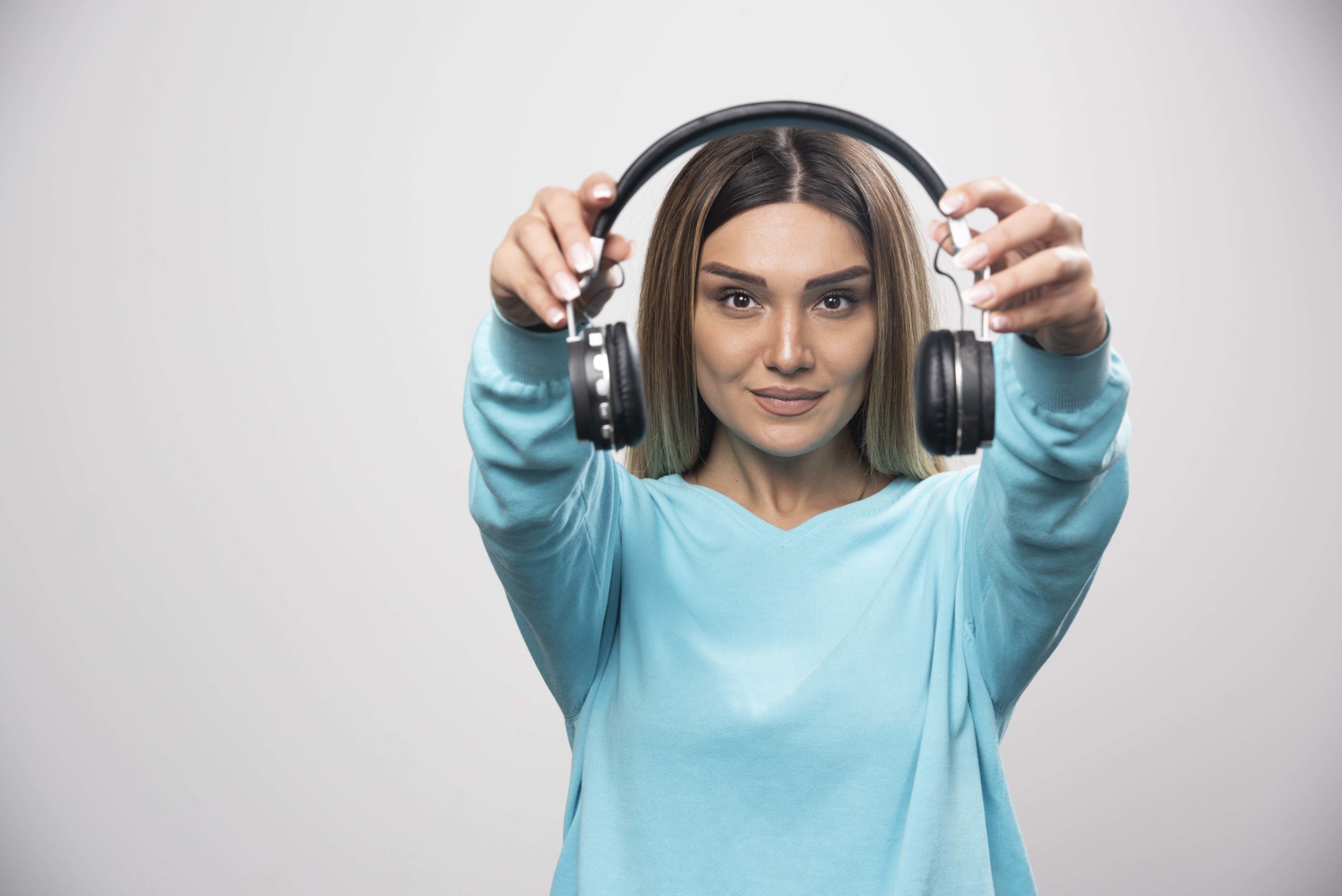
Another test we recommend is testing if you can still hear your headphones at a altitude.
For this, remove your headphones while music is still playing, and keep them at your usual volume level. Then, concur them out in front end of yous at an arm's length. Tin can you hear the music clearly? If so, try turning it downwardly and repeating once again.
Pro tip: Endeavour non to play a song you are very familiar with — you will conceptualize the lyrics or beats, and that tin can make you feel like the volume is high when it's actually low.
3. Check the volume control
There is no denying that some music is best listened to at louder levels. And it's and so elementary to crank upwardly the volumes when your favorite rails begins to play. It is important, though, to get into positive habits by ensuring that the book stays below 60% of the volume.
If you notice information technology creeping upwardly to over two-thirds of the volume control or over 60%, then it is likewise much for your ears.
"At lx% volume, you can nonetheless very clearly hear your music, and with good quality headphones, you'll be able to vibe forth to every beat out. Keeping the volume controlled is the easiest style to avoid any problems with hearing loss that relates to headphones."
– Carreen P. Henson, Clinical Audiologist
Hearing loss may not occur overnight, but you lot can prevent it from happening by monitoring those volumes on a regular ground.
Some headphones may withal produce audio louder than the recommended 85dB even at 60% book, depending on the headphone impedance. If that's the case, information technology's better to rely on a sound meter instead of the device book settings to measure the sound level accurately.
iv. Ensure yous don't struggle to hear people around you
If y'all struggle to option out sounds in your environment when wearing your headphones, then your volume may be too loud. You lot need to suit the sound until you can maintain a chat with someone in the same room.
Effort turning down the volume until your friend doesn't sound muffled.
Simply note that this test won't be effective if y'all accept noise-canceling headphones though.
five. Wait out for signs of hearing loss
You may already exist experiencing symptoms of hearing loss and don't realize it. This tin exist acquired past listening to your headphones at a high volume. Loud dissonance tin overwork and harm the pilus cells in the ear, and yous will gradually lose your hearing.
"Usual early sign of hearing loss is difficulty in speech understanding. I accept had many patients who come by in the dispensary who country that they do hear speech and sounds, but they have difficulty understanding some words."
– Carreen P. Henson, Clinical Audiologist
Look out for symptoms such as:
- Ringing, clicking, roaring, hissing, or buzzing in the ears
- Difficulty in hearing at rowdy venues
- Muffled sounds
- An increasing need to proceed turning the book up
Cheque out some more symptoms of hearing loss and then you lot tin can know what to look out for. However, information technology's prudent to consult with a professional person for a better diagnosis and handling of your hearing status.
6. Measure the sound level with a Sound Meter
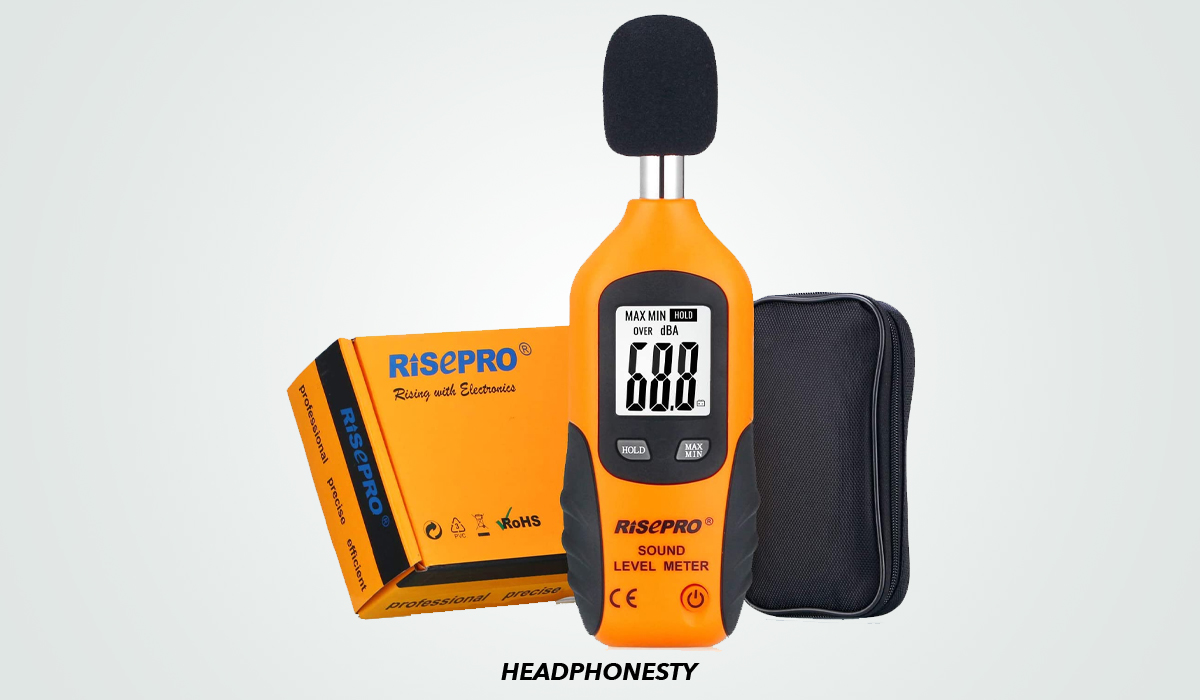
A sound or decibel meter is a device to measure audio levels in decibels (dB). With this device, you can make use of the decibel chart above to measure out if your headphones are as well loud for you.
Have note that although it says 94 dB is the average sound level for personal audio devices, it is nonetheless pretty damn loud. Keeping the audio level 10 – 20 decibels beneath that will requite your ears much relief in the long run.
To accurately measure out the book using the sound meter, follow these steps:
- Connect your headphones to your audio source and play a song/sound at your typical volume.
- Hold your headphones out and plow on your decibel meter.
- Place the decibel meter mic directly to the inner role of one of your headphones' earcups. The decibel meter should automatically show the electric current dB on its LED screen.
Measuring headphone volume with decibel meter (From: Youtube/Techscrew) - Suit the device book manually until it remains beneath 85dB.
Audio meters aren't e'er authentic simply it gives a good approximate. The sound projected into your ears vs the sound picked up by the meter tin can potentially be very different. Take the measurement with a pinch of salt.
If buying a sound meter is out of your budget, you can opt to try out different apps that tin can turn your gadgets into virtual volume measuring device. Some of our most recommended apps are:
- For Android: Sound Meter
- For iOS: Decibel X
- For Windows: Decibel Meter
How to Wear Headphones Without Damaging Your Hearing
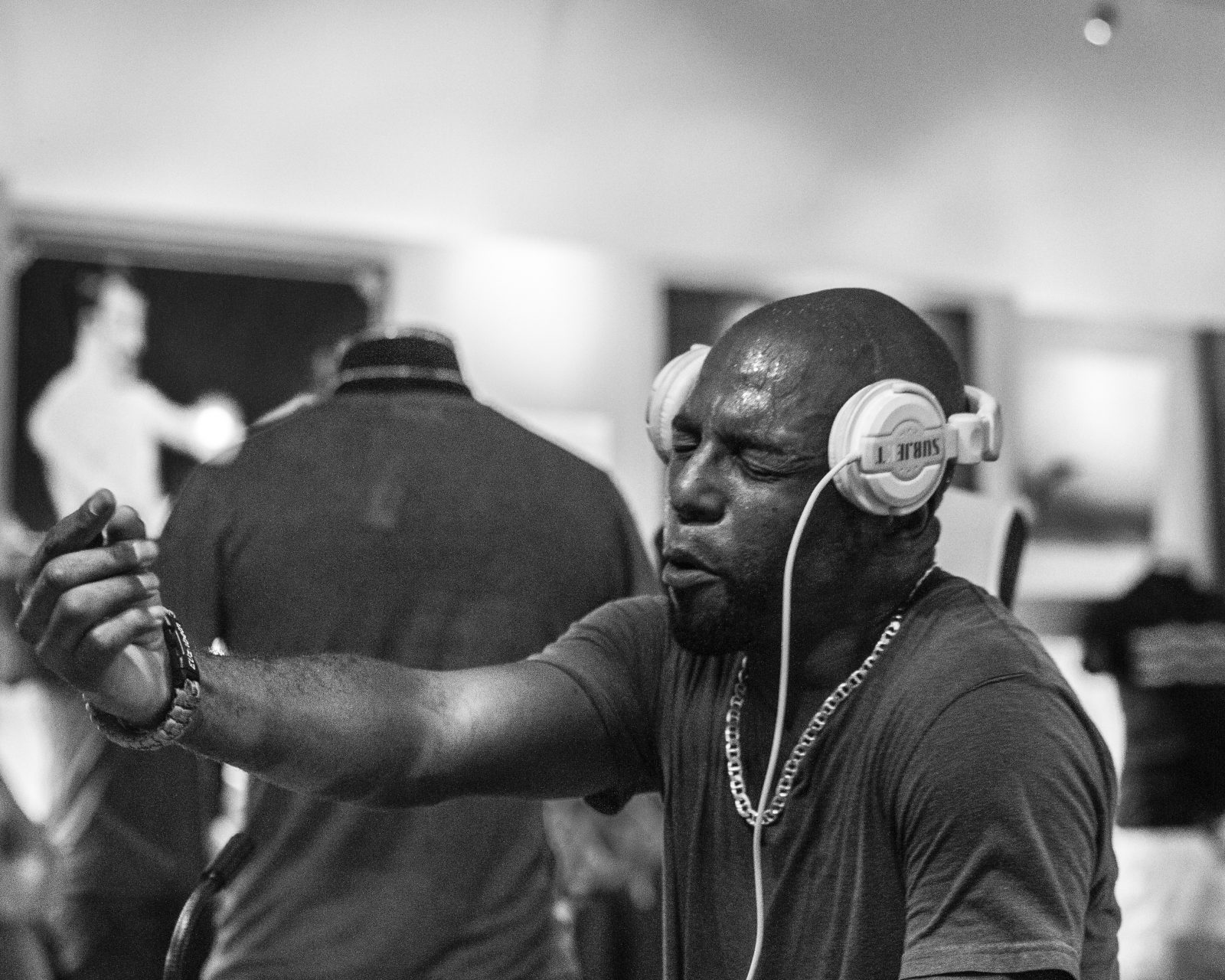
While headphones and earbuds present a potential danger of hearing loss, they aren't completely bad for your ears. It but depends on how you apply them.
That's why to avoid all these worries, hither's a list of a few preventative tips that will ensure y'all use your headphones safely. Let's swoop in:
- Be faithful to the sixty/lx rule
- Utilize book limits
- Utilize dissonance-canceling headphones
- Choose good-fitting headphones
- Utilize Equalizers
Exist faithful to the 60/60 rule
It can be tempting to heighten the volume on your favorite playlist so you tin can relish the music for an extended menses. But, you shouldn't practise that. Instead, Dr. Kelly Conroy, an audiologist, suggests sticking with the 60/threescore dominion.
Y'all demand to set the volume of your headphones to 60% and only mind to music for short periods of 60 minutes.
Luckily, this volition be easy to follow since your mobile device will requite you a warning when you turn upwards the volume beyond 60%.
Afterward the 60-infinitesimal marking, remove your headphones and even charge them if you demand to. This intermission gives the little hair cells in your ear canal a gamble to rest and recover from all the vibrations.
Utilize volume limits
There are two types of volume limits you lot can rely on to limit your exposure to loud sounds. They include built-in and settings-based volume limits.
Allow's break down each type:
Built-in volume limits
The book-limiting headphones are mostly designed for kids and people with sensitive hearing. These headphones are designed with built-in volume limits, where the sound level is gear up at a standard of 85dB.
While some volume-limiting headphones let switching from 85 to 96 dB, built-in volume limits can't be bypassed so you lot tin't adjust the settings to make the volume any louder than that.
Settings-based volume limits
If you're not into buying a new pair of headphones with congenital-in limits, you could fix volume limits direct from your sound source, whether it's a smartphone or tablet.
Hither's how to access the volume limit controls on both your iPhone and Android respectively:
How to enable book limits on iPhone
- Head to Settings and select Sound & Haptics.
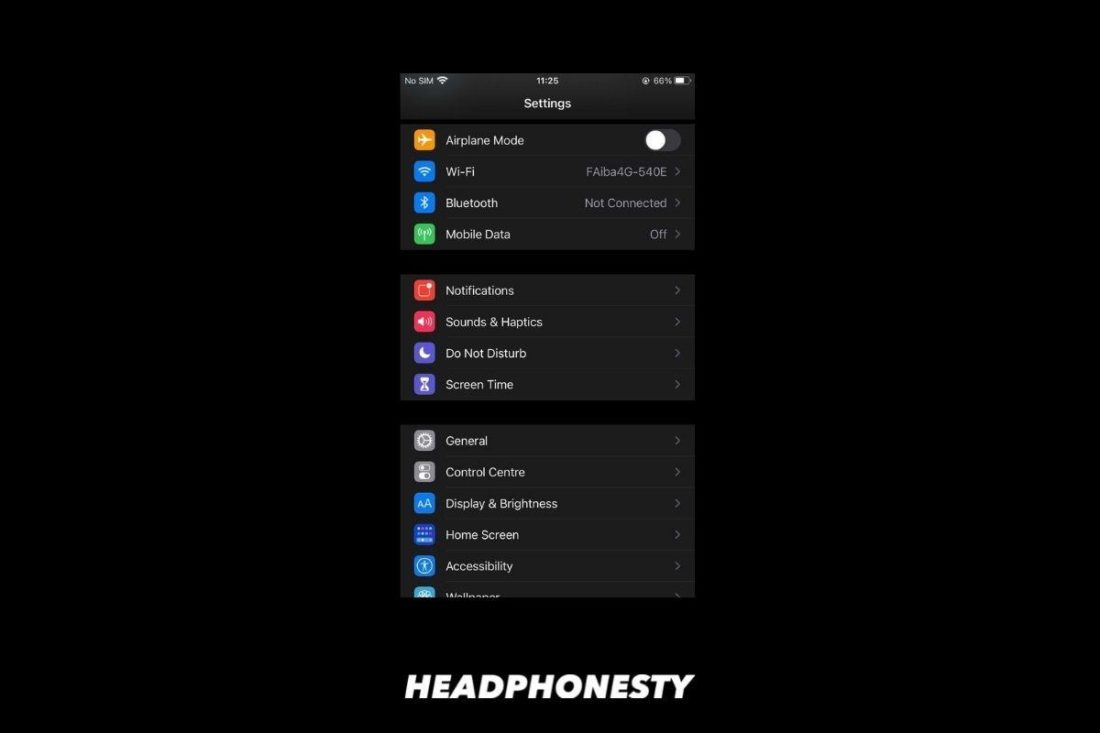
How to access Sound & Haptics on an iPhone. - Select Headphone Prophylactic.
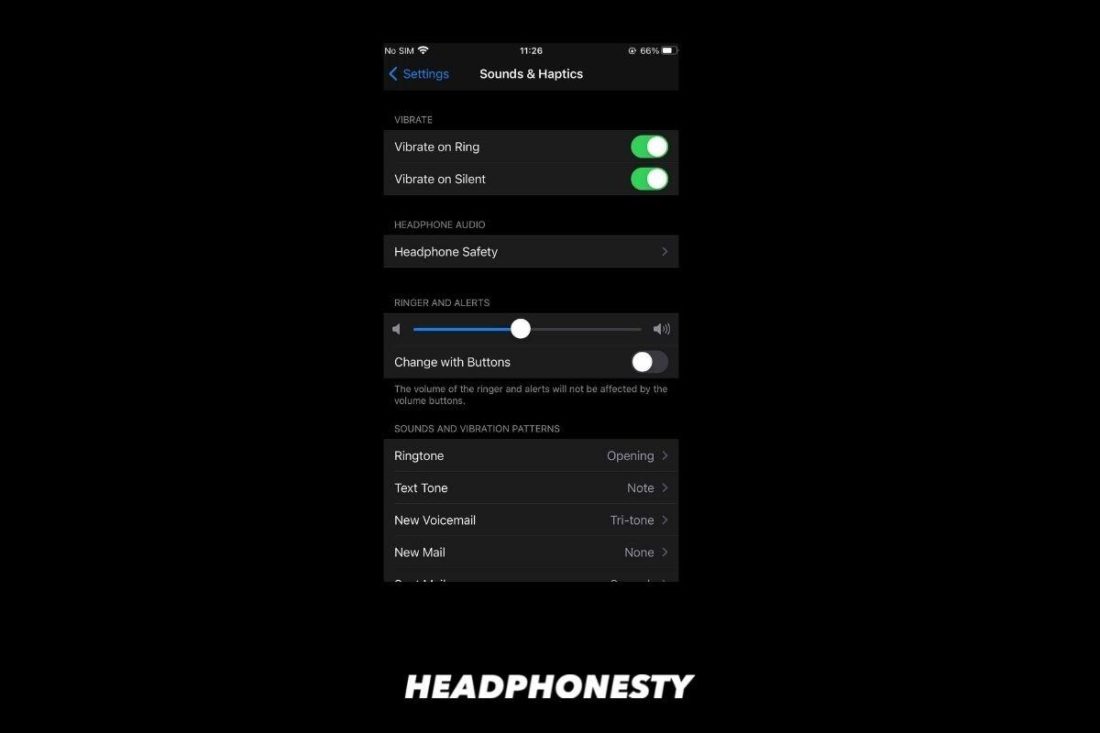
How to admission Headphone Safety on an iPhone. - Toggle the Reduce Loud Sounds button and set the sound level to a maximum of 85 decibels.
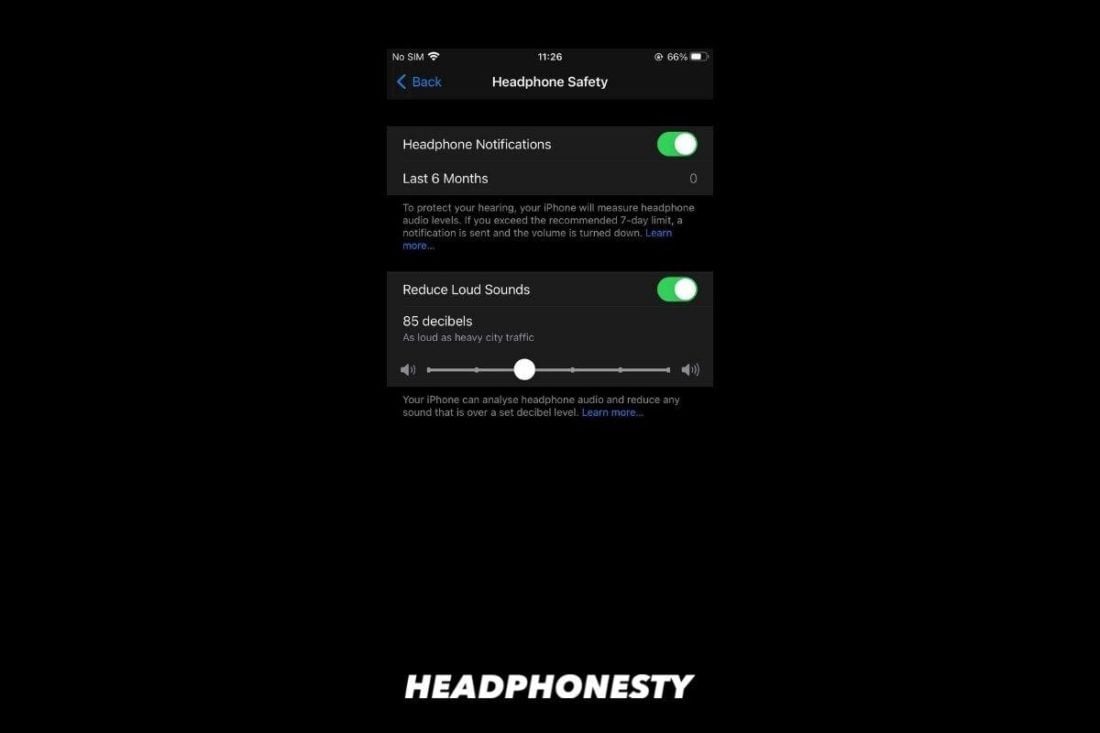
How to fix the maximum book limit on an iPhone.
How to enable volume limits on Android
- Head to Settings and select Sounds and Vibration.
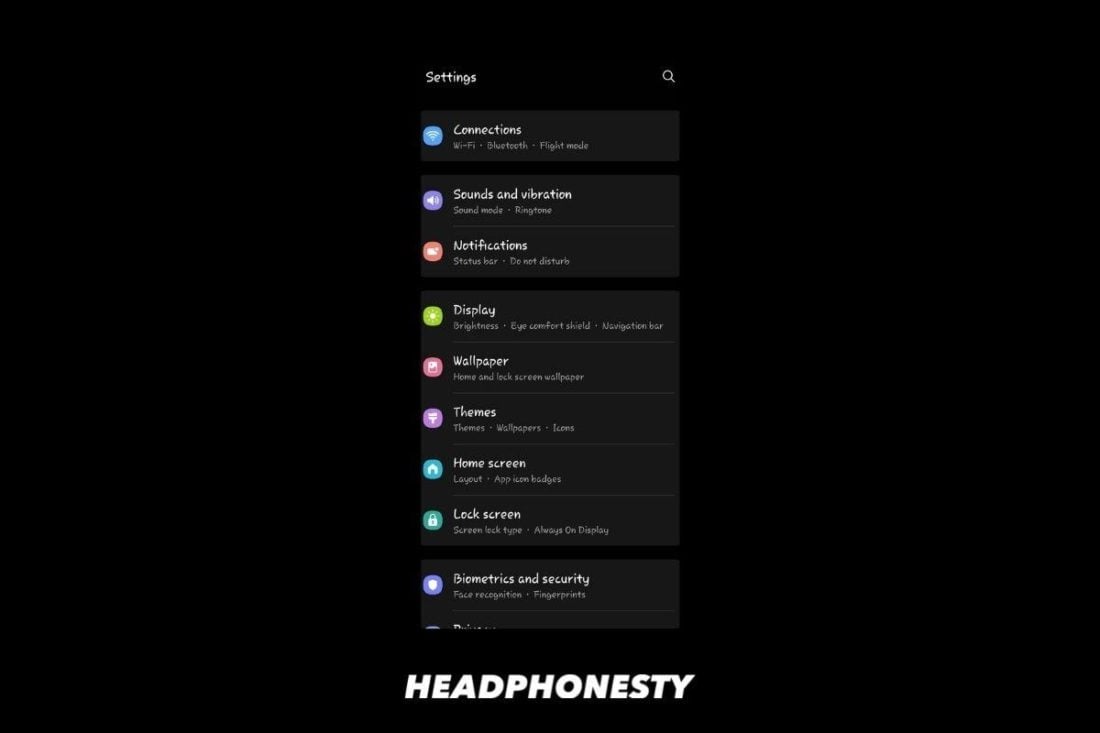
How to access Sounds and Vibration on an Android device. - Then select Book.
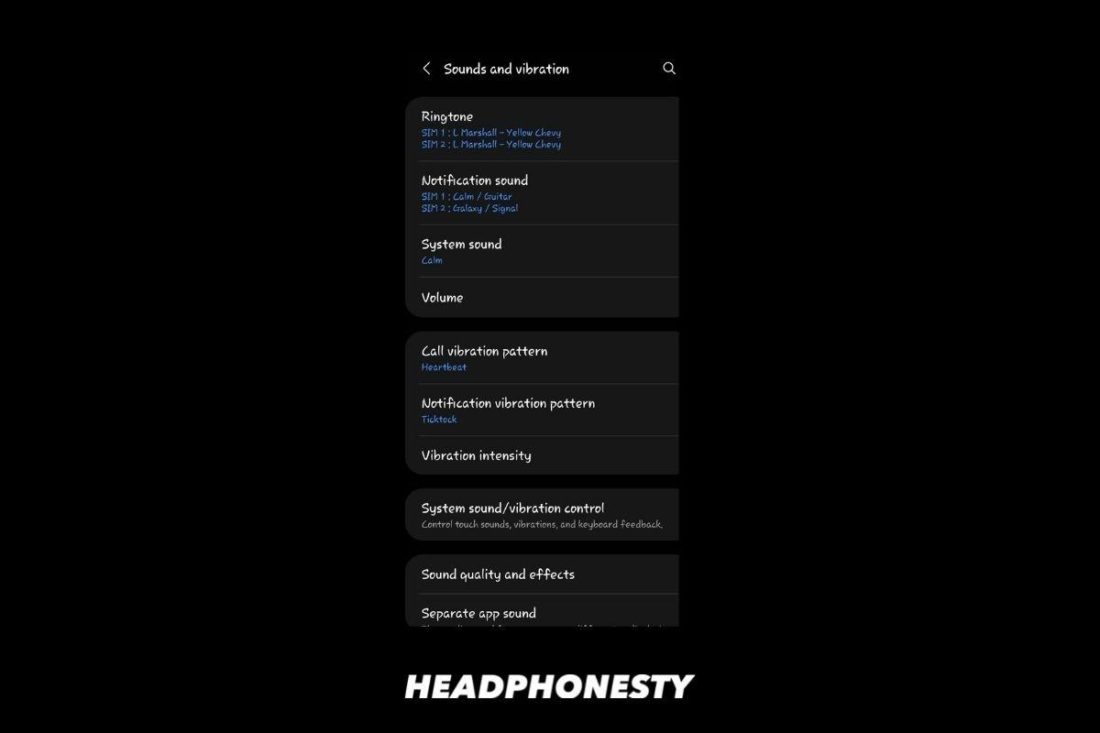
Tap on the Volume pick. - At the height right corner, tap the three buttons and select Media book limit.
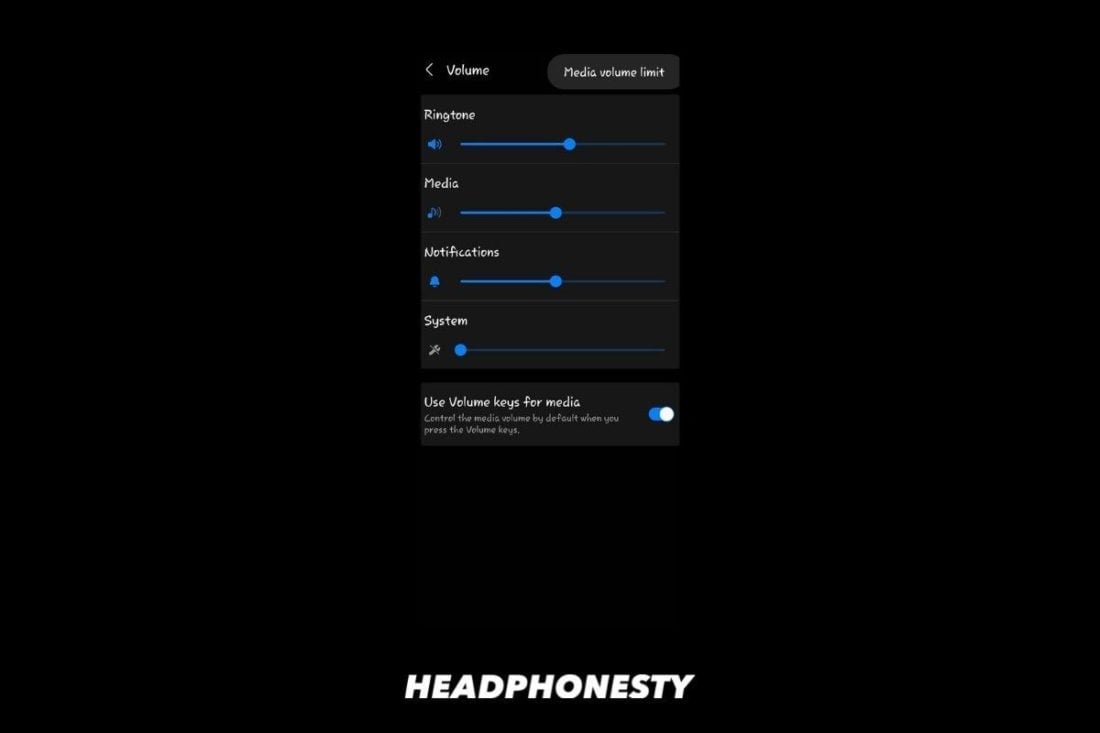
3 buttons at the top corner revealing the Media book limit. - Toggle the off push button to 'On' to customize the media volume limit.
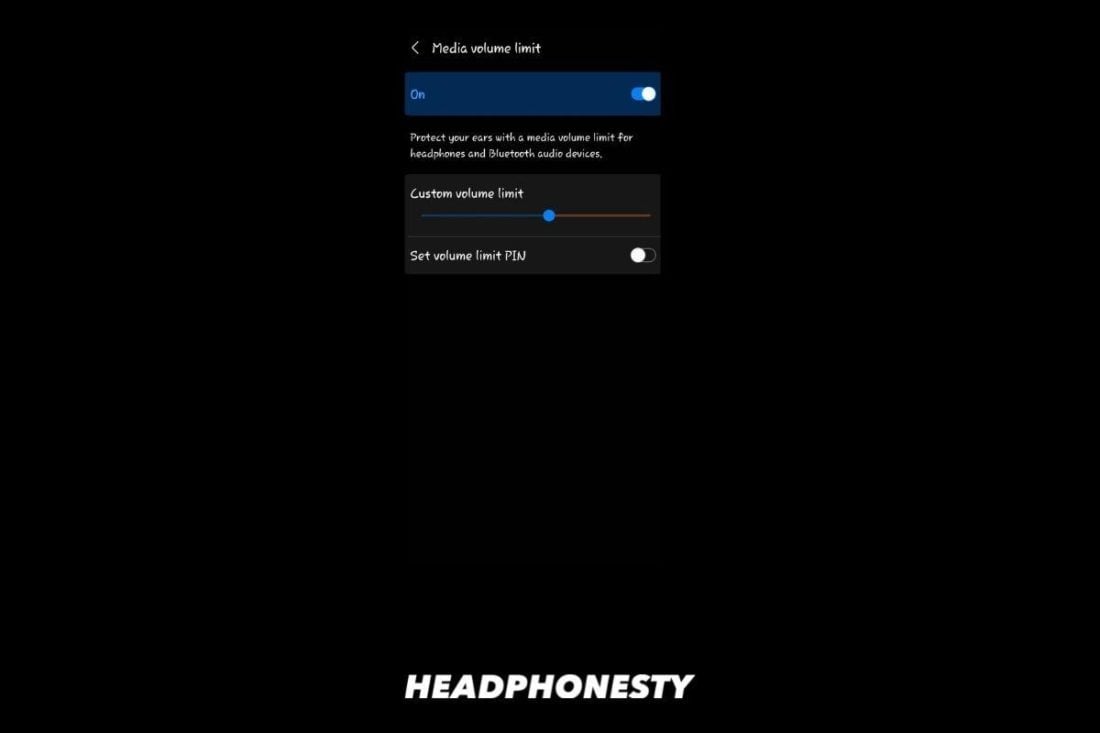
Customizing the book limits on an Android device.
You lot tin also effort using 3rd-party apps for such equally Volume Limiter or Book Control to maintain safe listening levels on your Android device.
Utilize noise-canceling headphones
At times, you may turn the volume high on your headphones to drown out the noise in your environment. To avoid this, yous could switch to dissonance-canceling headphones instead.
You can either have passive or active dissonance-canceling headphones. We recommend the latter since they actively cancel out unwanted background noise by emitting audio waves that oppose the incoming sound waves from the environment.
In dissimilarity, passive racket-canceling headphones, a.k.a. noise-isolating headphones, only create a concrete bulwark in your ears to muffle groundwork noise.
Racket-canceling headphones are safe merely recollect to continue observing the 60/lx listening dominion since prolonged use can notwithstanding impairment your ears.
Choose practiced-fitting headphones

The headphones' fit as well affects how well the headphones' noise cancellation works.
Having a pair of loose-plumbing equipment headphones tin also let in unwanted background racket since they can't fully seal your ears. This can make it seem like your music isn't loud enough and force y'all to turn it upwardly past the recommended volume limits.
To counter this, you lot should find a pair of well-fitting headphones that form a expert seal over your ears.
With this respect, people who clothing spectacles may experience like earbuds are a meliorate option than over-ear headphones. However, we recommend sticking to the latter. Since earbuds need to be inserted close to the ear canal, they tin crusade more damage than over-ear headphones.
Utilize Equalizers
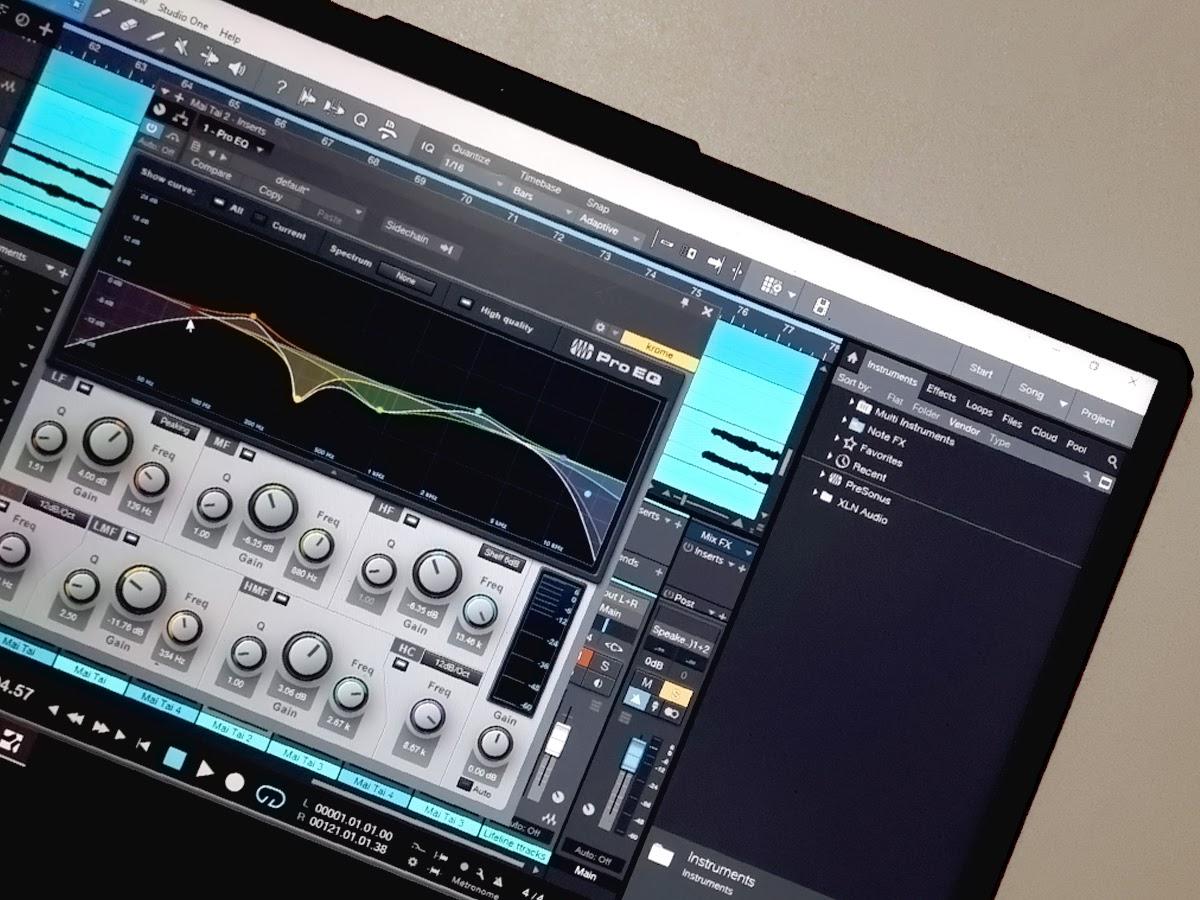
While lowering the headphone volume goes a long manner in preventing ear damage, it'due south not always going to work. This is because some sound frequencies can be more than dangerous than others, fifty-fifty when played at low volumes.
High-pitched noise (highs), in particular, tends to be more damaging than lows even when played at the same volume. The highs tin can brand your ears more than sensitive as they evangelize a striking pressure to your eardrum.
In contrast, lows are more tolerable in the ear, only prolonged vibrations tin can also destroy the hair cells.
As a way around this, y'all should consider customizing your headphone'south blaster settings. The equalizer lets you balance the highs, mids, and lows for safer listening. You can adjust the frequencies until you become a decent sound that doesn't crusade ear damage.
Conclusion
Hopefully, now you lot have everything y'all need to reduce the chances of early hearing loss, even for your kids. You won't have to put away your headphones, only only learn how to set volume limits and also limit your listening fourth dimension.
With time, you will capeesh the 60-minute music breaks as yous give your ears a take a chance to rest. Information technology will besides requite you lot the fourth dimension to curate a fresh playlist for your adjacent listening session.
Of form, information technology'south besides all-time to go on your hearing wellness in check.
"It is recommended that you have your hearing checked at to the lowest degree every 6 months or once a year regardless of whether you have hearing loss or not. Early on detection and management are always better to help preserve our hearing."
– Carreen P. Henson, Clinical Audiologist
Are your headphones giving you ear-related problems? Exercise you lot recollect the tips we offered volition help reduce the risk of ear damage? Drib a comment below and share your thoughts with us.

Source: https://www.headphonesty.com/2017/03/5-ways-to-know-that-your-headphones-are-too-loud/
0 Response to "If You Hold a Black Baby to Your Ear"
Post a Comment